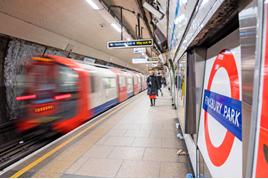Bienfait took as his example the six-track line between Brussels North and South. Current capacity is 92 trains per hour (tph), with a spare path inserted every four trains in order to maintain reliability. With consistent driving from ATO, he argued that the spare path could be removed - increasing capacity to 120tph.
Some drivers generate better fuel consumption figures than others. Just as with a car, much depends on the way they drive - harsh acceleration will increase fuel use. Alstom’s analysis suggests potential fuel savings of up to 42% for local trains (which stop frequently) and up to 15% for inter-city trains.
If a driver sets an ETCS train in motion, the ETCS kit will allow it to proceed only as far as the signalling says is safe. If the driver does nothing, it will stop at the next red signal (whether that’s a real signal or a marker board that represents the end of the train’s movement authority). The train stops because it knows where it is and the point beyond which it cannot go.
That’s not really different from instructing a passenger train to stop at a station. Both control where a train should stop, and for this reason they should both use the same principles and communications language.
But if there are similarities between ETCS and ATO, it’s also true that they should be separate. ETCS is the safety net, the limits beyond which a train must not go (in terms of speed or distance). ATO is the control of the train that must remain within the ETCS safety net.
At the European Union Agency for Railways (previously the European Rail Agency), ATO Project Officer Wouter Malfait argues that ATO is to make rail more competitive and only a little bit about making it safer. He says that ATO increases capacity, safety, performance, efficiency, punctuality and passenger comfort. It decreases costs, energy consumption, rail noise and pollution.
From a European perspective, the agency wants to avoid 25 different types of ATO with no interoperability between them. This is similar to the principles behind ETCS, which include the ability for a train equipped with ETCS in one country to operate on another country’s ETCS. This is particularly important for cross-border freight, and to a lesser extent passenger services. Having one standard for ATO to which several manufacturers’ equipment complies also brings a more open market.
For rolling stock owners this is important, Angel Trains Head of Product Management Euan Smith told the conference. Citing an RSSB project on standard couplers, he said that at privatisation there were three types of coupler while today there are 12. Even Class 220 and 221 Voyagers and Class 222 Meridians could not run together, despite being an outwardly similar train built by the same company. He warned against having different systems on different trains on different tracks, saying this would lead to difficulty interworking fleets and complicate fleet cascades or upgrades.
The lengthy and convoluted development of ETCS’s specification and standards shows that this admirable goal is easier to say than to deliver. Even as Britain leaves the European Union, a standard ATO has advantages in that Network Rail and train operators would not be in hock to a single supplier, as they would be in buying a proprietary system. (Thameslink uses a proprietary system because common ATO standards are still being developed.)
Malfait is determined to see a stable specification for ATO, because he recognised at the February conference that having to upgrade or retrofit kit would ruin the business case for ATO (which is chiefly driven by capacity increase and cost reduction).
Among the challenges is the need to agree standard trackside information that tells the train what’s down the line - in terms of gradients, for example. Unlike a Victoria Line train that can be programmed with the entire line’s characteristics, a go-anywhere European locomotive cannot hold on board full details of every line in Europe. This is one of the differences between metro and heavy rail operation that makes ATO harder for main line railways.
Information is vital to ATO, just as it is for a driver. Bombardier ATC System Engineer Jack Ratcliffe noted: “An ATO is only as good as the information you put in it.”
Britain faces further challenges because its railway is split between many companies and Network Rail is pushing towards route devolution. Delegates at February’s conference were concerned that there was no guiding mind and no central authority. They were also concerned that the costs would fall to train operators and owners while the benefits would go to Network Rail (not least in terms of having more capacity to sell).
Simmonds said that eight route studies would be completed by April, and that outline business cases at route level would incorporate whole-industry costs. It would then be for the Department for Transport to decide the best way to fund improvements over a whole-life basis. This might be via Network Rail or franchises, he suggested.
He called for new trains to be delivered ready for Digital Railway. Whether ETCS or ATO they should have common cabling, for example, to help reduce the costs of fitting equipment later. This should be agreed with the supply industry, he said.
The challenges of European co-operation and standards creation are not the only ones facing ATO. Unlike the subterranean Victoria Line, the national network is subject to a variety of weather that generates a variety of railhead conditions. It’s well known that autumn causes problems with traction and adhesion, as leaf mulch coats the railhead.
Companies tell drivers to brake more slowly, and they extend timetables to maintain punctuality. Despite this, performance figures drop every autumn. Thameslink plans to use an ETCS communications channel (packet 44) to instruct its Class 700s running in automatic mode to brake more slowly on a Monday morning, when engineering work might have closed parts of the track leading to rust on the railhead, according to Engineering Manager Jon Hayes.
Just as drivers are taught to recognise and react to poor braking conditions, so could ATO trains - provided they have a suitable way of telling the train management system in the local control centre. Once again, this is easy to say, but much harder to reliably and safely react to poor railheads.
Door control may also prove contentious. An on-board attendant might check that all doors are safely closed at each station before pressing a button to tell the train it can move. Or staff on the platform could check and signal via the control centre. The train might use sensors to check doors, but these sensors will need sufficient resolution to ‘see’ a trapped rucksack strap, arm or coat in a door. This should not be impossible, but (as with track conditions) it will take considerable effort to assure passengers and staff that it’s safe.
Further complications could come with platform edge doors, which will need to be linked to train systems to ensure safe departure from stations. Trains must also stop precisely so that train and platform doors align. This is easier if a uniform fleet calls at that platform. If not, then Britain might have to install moveable platform doors (as Japan has).
LU’s Jubilee Line already uses platform doors on its extension east to Stratford. Crossrail, which will use ATO in its central section, also has platform doors in that section. Its trains and drivers will need to switch from ATO to manual driving under standard signalling on the eastern section and manual driving under ETCS Level 2 on the western section.
Sensors, perhaps radar, will play a role in detecting obstacles in the track, whether they’re objects or people who should not be there. In recent years, lorries have fallen from bridges, containers have been blown from freight trains, and (as at Liverpool in February, RAIL 822) walls have collapsed onto the track. Drivers can spot obstacles but they can’t always stop their trains in time. An ATO system must also be able to spot obstacles and brake, but it too might not be able to stop short.
Preventing trespassers can cut this risk. This demands improved management by Network Rail of boundary fences. NR would also need to improve the way it manages and maintains structures (to prevent collapse) and vegetation (to prevent trees falling onto the line, for example). ATO should trigger changes to the way NR grants access to track workers.
London Underground has already encountered many of the problems that would face the national network in bringing ATO into use.
While the Victoria Line might not have adhesion problems caused by weather, the Central Line certainly does. Head of Rolling Stock Graham Neil told the conference that LU uses a combination of information from the London Weather Centre, a network of lineside moisture monitors and information from train wheelslip protection (WSP) monitors.
From this LU predicts likely rail adhesion and reduces brake rates or speeds, or reverts to manual driving if conditions are beyond ATO’s ability. Accordingly, it follows that a line cannot be used to its full capacity if it must cope with trains taking longer.
Imagine the size of such a monitoring operation if it must cover all Network Rail’s lines, rather than just the parts of LU that extend beyond the central tunnels.















Login to comment
Comments
No comments have been made yet.